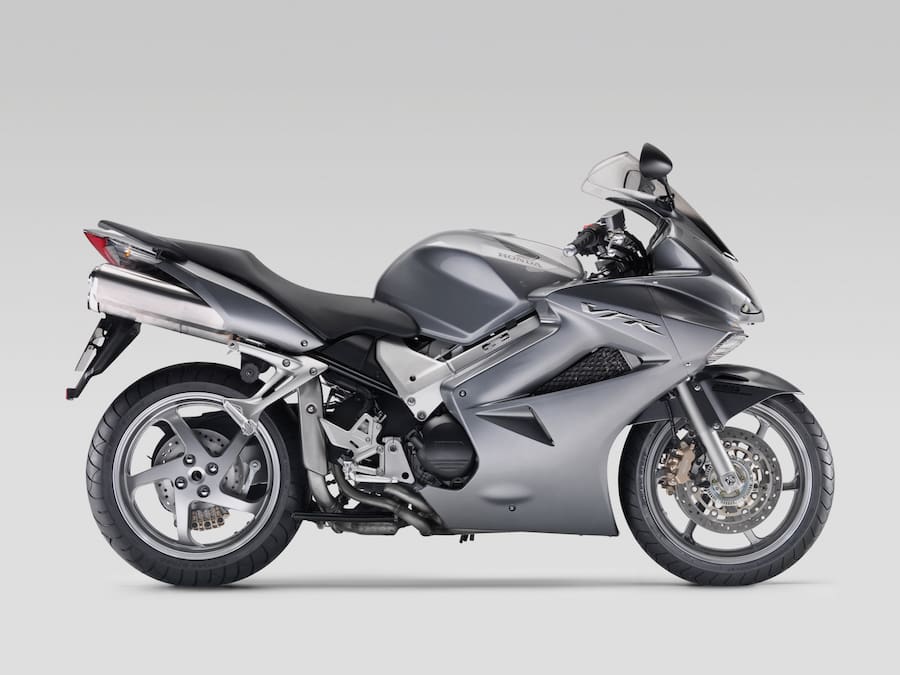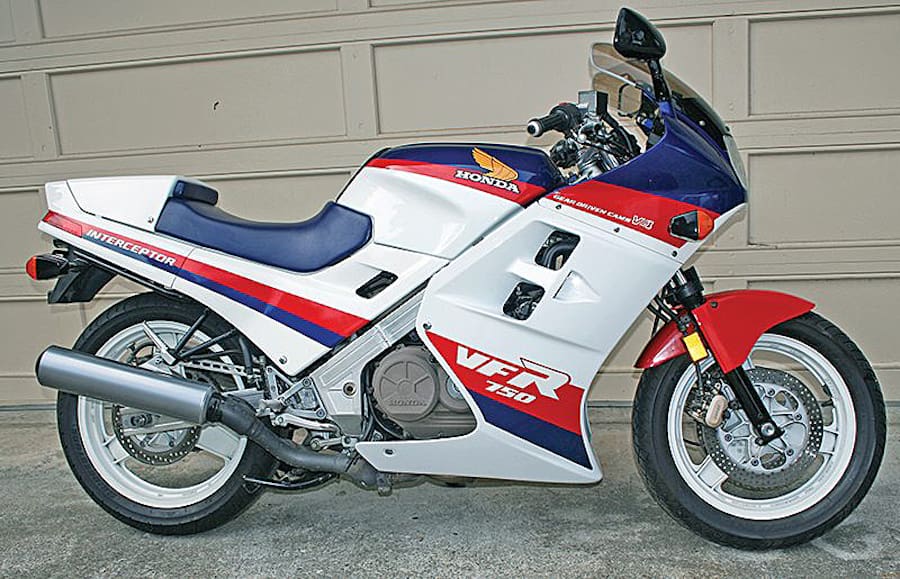The Honda VFR800F is widely acknowledged as a capable all-rounder, a fine, sophisticated motorcycle, a middleweight that fits neatly in the sports-touring category.
The fuel-injected 782cc engine is housed in an aluminium twin-spar frame riding on conventional cartridge forks and a handsome, monoshock-sprung, single-sided swingarm.
The twin front-disc/single rear-disc braking set-up was a linked system that subtly fed in some front braking when you applied the rear and vice versa. Most doubters become converts once they’ve tried it – the linked set-up was ultimately scrapped for post-2013 models, when ABS was added.
The relationship between the well-padded seat (height around 800mm) and the footpegs and ’bars makes VFRs comfortable for a wide range of rider and pillion sizes. The semi-crouch riding position feels natural and undemanding – fine for trickling through traffic and just right when rapidly splitting the breeze. While a dry weight of under 210kg means they’re not featherweights, they seem lighter on the road, with the bonus of feeling more stable than lighter sportsbikes.
The engine’s 80kW (107hp) output is pretty healthy for an 800 and the chassis enables you to use all of it confidently and effectively. “Always smooth. Always strong. With an exhaust note eerily reminiscent of a V8 muscle car,” is the way a mate summed up the unique engine. Its impressive mid-range grunt minimises use of the smooth-changing six-speed gearbox.
Ridden in anger a VFR is a lively bike that is capable of mixing it with dedicated sportsbikes. It’s a neutral steerer, with an ability to hold a precise, fast line through a bend, thanks to its balanced chassis and suspension characteristics. Its character is more ‘sport’ than ‘sports tourer’ and fuel consumption is reasonable, offering a safe touring range of over 350km from the 22-litre tank.
Of the numerous design revisions during the 20-year model run, the introduction of the VTEC-engine in 2002 was the big one. Gone was the low-slung single muffler, replaced by a trendy under-seat set-up. Gone also were the sexy gear-driven cams, with conventional chain-drive taking over. The big-ticket item was the new VTEC valve arrangement that operated only two-valves per cylinder up to about 6700rpm, bolstering mid-range performance, with the extra two-per-pot then chiming in as the tacho rushes toward the 11,700rpm ceiling. The engine’s suddenly fierce four-valve howl is pleasingly angry and animalistic.
From 2006 onward, the slightly harsh VTEC transition between two and four-valve modes was softened – further finessing also occurred in 2014, boosting mid-range torque. Traction control also appeared in the new generation machine of 2014.
There’s actually little real-world performance difference between pre-VTEC and VTEC models and the VTEC transition behaviour is more a ‘character’ thing than a real issue.
While the underseat exhaust set-up on the 2002-13 models wins styling kudos, it hurts pillion comfort and limits luggage options.
Comments in this review are also broadly applicable to the VFR800X soft roader released in 2011 and which featured minor engine mods, higher ground clearance and longer-travel suspension
A VFR800 is easy to ride in all conditions and very forgiving, flattering its rider’s skills. While providing much of the performance of a pure sportsbike it’s a more comfortable and practical mount for everyday riding and touring duties.
And there’s the bonus of the peace of mind that for many comes with Honda ownership.

What to look for
The whole VFR powertrain is pretty much bullet-proof and impressively long-lived given decent maintenance. Some early bikes will have had dodgy regulator/rectifiers – a Honda thing – replaced by beefier aftermarket units.
Thoroughly check the condition of the fairings and seat cowl. Damaged plastics are costly to replace.
As always adjust your offer to cover worn consumables like chain, sprockets, steering-head bearings and brake pads, also brake rotors close to minimum thickness.
The ideal prospect is a neat and tidy example with a full service record.
Service history
The VFR800 is a reliable machine that’s straightforward enough for DIY-owners to carry out basic maintenance. Access is reasonable (with the fairing removed) for routine servicing like oil and filter changes at 6000km intervals. However, be aware that valve clearance checking and correcting – required at 24,000km intervals – is a big, complex and costly job that adds to the cost of ownership, especially on VTEC engines. For experienced DIY-owners with the right equipment it’s still a big, complex job.
New Price
$13,990 (1998)
$14,050 (2013)
Building bricks
The ancestry
HONDA VF750F
1983 – Honda’s pioneering V4 sportsbike gets the V4-show on the road before blotting its copybook with soft camshafts and quality issues.

HONDA VFR750F
1986 – Determined to salvage its reputation Honda launches a new over-engineered sportsbike the VFR750. No stumbles this time. It’s a V4-star.

HONDA VFR750R (RC30)
1988 – Any remaining doubts about Honda’s V4-powered sportsbikes are put to rest following the release of this iconic racebike-with-lights.

WORDS Rob Blackbourn
PHOTOGRAPHY AMCN ARCHIVES











